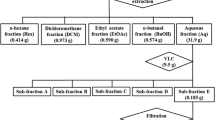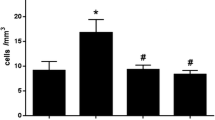Abstract
The classic NLRP3 inflammasome and NF-κB molecular pathways are activated in many inflammatory-related diseases, such as pleurisy. Because oridonin (Ori) has been indicated as a covalent NLRP3 inhibitor with strong anti-inflammasome activity, we herein aimed to assess the effects of Ori in a mouse model of carrageenan (CAR)-induced pleurisy. The results showed that CAR caused hemorrhaging and exudation of lung tissues and the release of inflammatory factors (TNF-α, IL-6 and IL-1β), effects that were significantly reduced by treatment with Ori. In addition, increased neutrophil infiltration, protein concentrations and volumes were found in the exudates of the CAR group, and these phenomena were suppressed by Ori treatment. Regarding cellular pathways, Ori could alleviate the CAR-activated NF-κB and TXNIP/NLRP3 pathways. Additionally, oxidative stress was shown to be involved in the pathogenesis of pleurisy, but possible mechanisms remain to be explored. Herein, Ori reversed the CAR-induced depletion of GSH and SOD and the CAR-induced increases in ROS, MPO and MDA levels. Furthermore, Ori inhibited NOX-4 levels, initiated the dissociation of KEAP-1 from Nrf2, activated the downstream genes HO-1 and exerted antioxidative effects on CAR-induced pleurisy. In conclusion, Ori conferred protection against CAR-induced pleurisy via Nrf2-dependent antioxidative and NLRP3-dependent anti-inflammatory properties.







Similar content being viewed by others
References
Bayir Y, Un H, Cadirci E, Akpinar E, Diyarbakir B, Calik I, Halici Z (2019) Effects of Aliskiren, an RAAS inhibitor, on a carrageenan-induced pleurisy model of rats. An Acad Bras Cienc 91(1):e20180106
Cao Z, Fang Y, Lu Y, Tan D, Du C, Li Y, Ma Q, Yu J, Chen M, Zhou C, Pei L, Zhang L, Ran H, He M, Yu Z, Zhou Z (2017) Melatonin alleviates cadmium-induced liver injury by inhibiting the TXNIP-NLRP3 inflammasome. J Pineal Res 62(3):e12389
Coll RC, Robertson AA, Chae JJ, Higgins SC, Munoz-Planillo R, Inserra MC, Vetter I, Dungan LS, Monks BG, Stutz A, Croker DE, Butler MS, Haneklaus M, Sutton CE, Nunez G, Latz E, Kastner DL, Mills KH, Masters SL, Schroder K, Cooper MA, O'Neill LA (2015) A small-molecule inhibitor of the NLRP3 inflammasome for the treatment of inflammatory diseases. Nat Med 21(3):248–255
Deshmukh P, Unni S, Krishnappa G, Padmanabhan B (2017) The Keap1-Nrf2 pathway: promising therapeutic target to counteract ROS-mediated damage in cancers and neurodegenerative diseases. Biophys Rev 9(1):41–56
Ekuadzi E, Biney RP, Benneh CK, Osei Amankwaa B, Jato J (2018) Antiinflammatory properties of betulinic acid and xylopic acid in the carrageenan-induced pleurisy model of lung inflammation in mice. Phytother Res 32(3):480–487
Fusco R, Gugliandolo E, Biundo F, Campolo M, Di Paola R, Cuzzocrea S (2017) Inhibition of inflammasome activation improves lung acute injury induced by carrageenan in a mouse model of pleurisy. FASEB J 31(8):3497–3511
Gaidt MM, Hornung V (2018) The NLRP3 Inflammasome Renders Cell Death Pro-inflammatory. J Mol Biol 430(2):133–141
He H, Jiang H, Chen Y, Ye J, Wang A, Wang C, Liu Q, Liang G, Deng X, Jiang W, Zhou R (2018) Oridonin is a covalent NLRP3 inhibitor with strong anti-inflammasome activity. Nat Commun 9(1):2550
Hou Y, Wang Y, He Q, Li L, Xie H, Zhao Y, Zhao J (2018) Nrf2 inhibits NLRP3 inflammasome activation through regulating Trx1/TXNIP complex in cerebral ischemia reperfusion injury. Behav Brain Res 336:32–39
Hu Q, Zhang T, Yi L, Zhou X, Mi M (2018) Dihydromyricetin inhibits NLRP3 inflammasome-dependent pyroptosis by activating the Nrf2 signaling pathway in vascular endothelial cells. BioFactors 44(2):123–136
Hybertson BM, Gao B, Bose SK, McCord JM (2011) Oxidative stress in health and disease: the therapeutic potential of Nrf2 activation. Mol Aspects Med 32(4–6):234–246
Islam MT (2017) Oxidative stress and mitochondrial dysfunction-linked neurodegenerative disorders. Neurol Res 39(1):73–82
Jeong YH, Park JS, Kim DH, Kim HS (2016) Lonchocarpine increases Nrf2/ARE-mediated antioxidant enzyme expression by modulating AMPK and MAPK signaling in brain astrocytes. Biomol Ther (Seoul) 24(6):581–588
Jiang W, Li M, He F, Zhou S, Zhu L (2017) Targeting the NLRP3 inflammasome to attenuate spinal cord injury in mice. J Neuroinflammation 14(1):207
Kass SM, Williams PM, Reamy BV (2007) Pleurisy. Am Fam Physician 75(9):1357–1364
Kovac S, Angelova PR, Holmstrom KM, Zhang Y, Dinkova-Kostova AT, Abramov AY (2015) Nrf2 regulates ROS production by mitochondria and NADPH oxidase. Biochim Biophys Acta 1850(4):794–801
Light RW (2003) Pleural diseases. Curr Opin Pulm Med 9(4):251–253
Lu MC, Ji JA, Jiang ZY, You QD (2016) The Keap1-Nrf2-ARE Pathway As a Potential Preventive and Therapeutic Target: An Update. Med Res Rev 36(5):924–963
Lu Y, Sun Y, Zhu J, Yu L, Jiang X, Zhang J, Dong X, Ma B, Zhang Q (2018) Oridonin exerts anticancer effect on osteosarcoma by activating PPAR-gamma and inhibiting Nrf2 pathway. Cell Death Dis 9(1):15
Lv H, Liu Q, Wen Z, Feng H, Deng X, Ci X (2017) Xanthohumol ameliorates lipopolysaccharide (LPS)-induced acute lung injury via induction of AMPK/GSK3beta-Nrf2 signal axis. Redox Biol 12:311–324
Mangali S, Bhat A, Udumula MP, Dhar I, Sriram D, Dhar A (2019) Inhibition of protein kinase R protects against palmitic acid-induced inflammation, oxidative stress, and apoptosis through the JNK/NF-kB/NLRP3 pathway in cultured H9C2 cardiomyocytes. J Cell Biochem 120(3):3651–3663
Nardi GM, Siqueira Junior JM, Delle Monache F, Pizzolatti MG, Ckless K, Ribeiro-do-Valle RM (2007) Antioxidant and anti-inflammatory effects of products from Croton celtidifolius Bailon on carrageenan-induced pleurisy in rats. Phytomedicine 14(2–3):115–122
Nennig SE, Schank JR (2017) The Role of NFkB in drug addiction: beyond inflammation. Alcohol Alcohol 52(2):172–179
Pereira Dos Santos Nascimento MV, Arruda-Silva F, Gobbo Luz AB, Baratto B, Venzke D, Mendes BG, Frode TS, Geraldo Pizzolatti M, Dalmarco EM (2016) Inhibition of the NF-kappaB and p38 MAPK pathways by scopoletin reduce the inflammation caused by carrageenan in the mouse model of pleurisy. Immunopharmacol Immunotoxicol 38(5):344–352
Salvemini D, Wang ZQ, Bourdon DM, Stern MK, Currie MG, Manning PT (1996) Evidence of peroxynitrite involvement in the carrageenan-induced rat paw edema. Eur J Pharmacol 303(3):217–220
Tada Y, Suzuki J (2016) Oxidative stress and myocarditis. Curr Pharm Des 22(4):450–471
Taguchi K, Yamamoto M (2017) The KEAP1-NRF2 system in cancer. Front Oncol 7:85
Wang Y, Gu YH, Liu M, Bai Y, Wang HL (2017) Fluoxetine protects against methamphetamineinduced lung inflammation by suppressing oxidative stress through the SERT/p38 MAPK/Nrf2 pathway in rats. Mol Med Rep 15(2):673–680
Wang Y, Huang Y, Xu Y, Ruan W, Wang H, Zhang Y, Saavedra JM, Zhang L, Huang Z, Pang T (2018) A Dual AMPK/Nrf2 activator reduces brain inflammation after stroke by enhancing microglia M2 polarization. Antioxid Redox Signal 28(2):141–163
Ward PA (2010) Oxidative stress: acute and progressive lung injury. Ann N Y Acad Sci 1203:53–59
Wu Q, Yao B, Li N, Ma L, Deng Y, Yang Y, Zeng C, Yang Z, Liu B (2017) Nrf2 mediates redox adaptation in NOX4-overexpressed non-small cell lung cancer cells. Exp Cell Res 352(2):245–254
Xue EX, Lin JP, Zhang Y, Sheng SR, Liu HX, Zhou YL, Xu H (2017) Pterostilbene inhibits inflammation and ROS production in chondrocytes by activating Nrf2 pathway. Oncotarget 8(26):41988–42000
Yang CP, Liu YC (2018) Therapeutics for inflammatory-related diseases based on plasmon-activated water: a review. Int J Mol Sci 19(6):1589
Yang Z, Guan Y, Li J, Li L, Li Z (2018) Chrysin attenuates carrageenan-induced pleurisy and lung injury via activation of SIRT1/NRF2 pathway in rats. Eur J Pharmacol 836:83–88
Ye X, Zuo D, Yu L, Zhang L, Tang J, Cui C, Bao L, Zan K, Zhang Z, Yang X, Chen H, Tang H, Zu J, Shi H, Cui G (2017) ROS/TXNIP pathway contributes to thrombin induced NLRP3 inflammasome activation and cell apoptosis in microglia. Biochem Biophys Res Commun 485(2):499–505
Zhang M, Pan H, Xu Y, Wang X, Qiu Z, Jiang L (2017) Allicin decreases lipopolysaccharide-induced oxidative stress and inflammation in human umbilical vein endothelial cells through suppression of mitochondrial dysfunction and activation of Nrf2. Cell Physiol Biochem 41(6):2255–2267
Zhang L, Previn R, Lu L, Liao RF, Jin Y, Wang RK (2018) Crocin, a natural product attenuates lipopolysaccharide-induced anxiety and depressive-like behaviors through suppressing NF-kB and NLRP3 signaling pathway. Brain Res Bull 142:352–359
Zhu C, Dong Y, Liu H, Ren H, Cui Z (2017) Hesperetin protects against H2O2-triggered oxidative damage via upregulation of the Keap1-Nrf2/HO-1 signal pathway in ARPE-19 cells. Biomed Pharmacother 88:124–133.
Acknowledgements
This work was supported by the National Natural Science Foundation of China (Grant No. 81870030) and the General Financial Grant from the China Postdoctoral Science Foundation (Grant No. 2018T110257).
Author information
Authors and Affiliations
Corresponding authors
Ethics declarations
Conflict of interest
The authors have no conflicts of interest to declare.
Additional information
Publisher's Note
Springer Nature remains neutral with regard to jurisdictional claims in published maps and institutional affiliations.
Rights and permissions
About this article
Cite this article
Yang, H., Huang, J., Gao, Y. et al. Oridonin attenuates carrageenan-induced pleurisy via activation of the KEAP-1/Nrf2 pathway and inhibition of the TXNIP/NLRP3 and NF-κB pathway in mice. Inflammopharmacol 28, 513–523 (2020). https://doi.org/10.1007/s10787-019-00644-y
Received:
Accepted:
Published:
Issue Date:
DOI: https://doi.org/10.1007/s10787-019-00644-y




